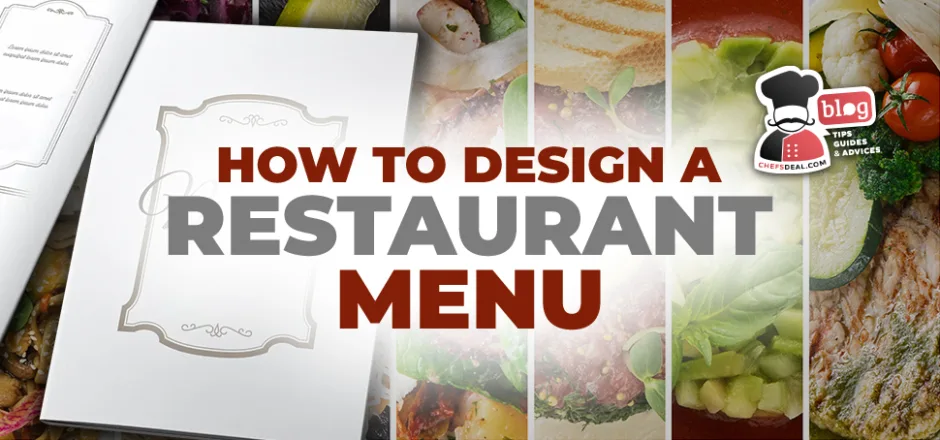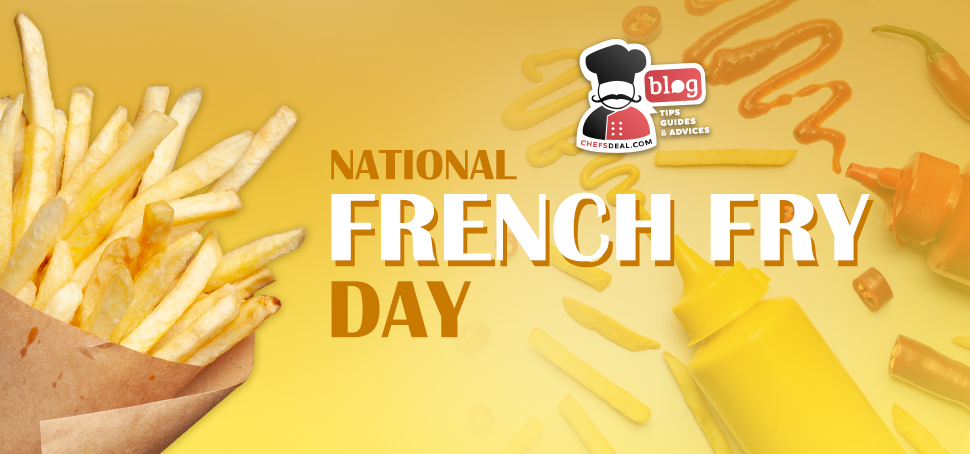Restaurant menu design is a defining moment for foodservice businesses. By including and excluding certain meals, you decide on a cuisine, a customer base, and a definitive list of commercial kitchen equipment you will need to create those meals. A well-designed menu will match your expertise and kitchen’s capabilities while showing your customers a clear picture of your business.
Cooking in commercial settings requires much more than basic machinery, and the expectations are higher than they are for home-cooked meals. Each item on the menu must be backed by a wide variety of equipment to meet the diners’ expectations. Read on to discover how to design a restaurant menu that matches your commercial kitchen equipment capabilities.
How important is Restaurant Menu Design in the Foodservice Business?
Menus are the guides you hand to your customers when they enter your business. They are much more than simple lists, and by paying close attention to their designs, you can increase your profits and manage your customers’ requests and expectations. Here are 5 simple but effective ways a menu can make all the difference:
- You can lead your customers to order certain meals and drinks by highlighting them on your menu. Most customers make impulse decisions based on their surroundings. You can promote low-cost, high-profit products by utilizing images, colors, titles, and placement.
- The menu will highlight the personality of your business and set the tone. You should opt for more elegant designs for high-end establishments and playful designs for casual ones. Creating a special children’s menu is also a good idea to impress families.
- The menu is a claim of authority over a certain cuisine or meal. By creating a unified list of items, you can set your claim over certain delicacies and leave a trustworthy impression on your customers.
- Grouping your foods and drinks properly and creating connections through discount menus can increase the likelihood of a customer buying more items.
- The food and drinks you want to sell will define the equipment you will need. For instance, if you wish to open a pizzeria, you will need specific products such as ovens and processors. Without the right equipment to back you up, your pizza won’t taste as it should and will be an unsuccessful venture in the long term.
Understanding Your Commercial Kitchen Equipment
Each commercial kitchen equipment is designed with specific goals and functions in mind. Knowing your machines’ capabilities and what you need to cook and prepare certain products will help you maximize your success. If you are unsure of what you can do with what you have or what you might need to cook and prep your menu items pay attention to the following:
- Equipment Capacity: Assess the capacity of your equipment. For instance, if you plan to serve iced drinks during summer, you should have a commercial ice maker that can meet the demands of your customers. A countertop model with very limited capacity won’t be enough to support the iced menu items.
- Type of Equipment: Make sure you have the right kind of products. Most commercial kitchens are equipped with ovens and grills, but if you intend to specialize in pizza and burgers, you will need specially designed machinery. For instance, most people avoid pizza in Venice, despite being an Italian city, because cafes and restaurants in the city are not allowed to use wood-burning pizza ovens, which are the traditional models. The right equipment will set you apart and establish you as a reliable business.
- Multifunction Equipment: Most products can be used for various purposes. Knowing the functions of your current equipment helps you diversify your menu. For instance, food processors, prep tables, fryers, slicers, and similar items could be all used in preparing paninis, burgers, pizzas, sandwiches, and more. You can easily broaden your menu by purchasing multi-purpose equipment without needing too many new items.
- Equipment Upgrades: Consider equipment upgrades to open up new possibilities for your menu. By upgrading, you can introduce innovative dishes and improve overall kitchen efficiency.
Menu Planning and Equipment Alignment
Aligning your commercial kitchen equipment with the items you wish to list on your menu will help you create a realistic and achievable goal. Most businesses gravitate towards popular dishes in the initial stages of their foodservice career to attract more customers. The following popular dishes will need the listed items:
Pizza
- Pizza ovens
- Refrigerated prep tables
- Slicers
- Food processors
- Griddles
- Pizza boards
Mexican
- Cheese melters
- Tortilla presses
- Chip warmers
- Steamers
- Fryers
- Food processors
Bar drinks and beverages
- Ice machines (undercounter or otherwise)
- Undercounter freezers and coolers
- Bar blenders
- Glasswashers (dishwashers for delicate beverage glasses)
- Keg coolers
- Beverage dispensers
Fast Food (Burgers)
- Fryers
- Griddles
- Slicers
- Toasters
- Charbroiler
You can browse the business type section on our website to get more detailed insight into what your business model might need in the kitchen.
Incorporating Flexibility in Restaurant Menu Design
If your budget does not allow you to expand your collection or capacity, you can take some measures to incorporate flexibility into your menu.
- Marking certain hours and offering some dishes and beverages in that limited time will let you adjust the expectations of customers based on your capabilities. If you don’t have the means to store or cool enough orange juice for a whole day, you can label it as a breakfast-only option.
- Offering alternative ingredients for the items on the menu will help you keep your customers happy. Businesses with low storage capacity might run out of ingredients on a busy day. Instead of telling your customers they can’t have what they want, include alternatives with ingredient substitutions on your menu to encourage them to stay.
- Highlight the products you always have as specials and place them in the middle of the menu with big visuals. Most people pay attention to the center first, and meals labeled as specials are more likely to be ordered by first-time customers looking to get to know your business. You can lower the possibility of rejecting customer orders by leading them to these products.
- Online menus are a new novelty foodservice acquired during covid. These menus are the most flexible form a menu can have by enabling your customers to reach the menu mostly via a QR code. While they lack certain nuances of a print menu, they let you update the items throughout the day. You can remove what you can’t offer and replace them with alternatives to keep the customers happy.

Menu Engineering for Profitability
Menu engineering is a strategic approach restaurants use to optimize their offerings for increased profitability. It involves a careful analysis of each menu item’s popularity and profitability. By categorizing dishes into different segments based on their sales performance and contribution margins, restaurants can identify the star items that are both popular and profitable.
With this understanding, businesses can strategically position and promote high-profit dishes, rework less profitable items, or eliminate those that do not contribute to the overall profitability. Through menu engineering, restaurants can drive customer satisfaction while maximizing revenue and profitability.
Menu Pricing Strategies for Profitability
Menu pricing strategies play a crucial role in ensuring the financial success of a restaurant. Analyzing the profitability of menu items involves a comprehensive assessment of the costs of ingredients, preparation time, and equipment used for each dish. By understanding the contribution margin of each item (the difference between the cost and the selling price), restaurants can avoid pricing their dishes too low, which might lead to financial losses, or too high, which might discourage customers from coming in. The 6 considerations while pricing your menu are:
- The cost of materials
- Different ingredient and equipment providers for budget reasons
- Seasonal fluctuations regarding the demand for certain products
- The time needed to prepare the meal
- Staff needed to maintain operations
- Consistent expenses such as rent and utilities.
Striking the right balance between value for customers and profitability for the business is key to maintaining a competitive edge in the market.
Adjusting Prices Based on Ingredient Costs and Equipment Usage
To maintain profitability, restaurants must adjust menu prices periodically to keep up with the changes in ingredients and equipment usage costs. Fluctuations in the prices of raw materials like produce, meat, and dairy directly impact a dish’s profitability. When ingredient costs rise, businesses should consider increasing menu prices accordingly to sustain their margins.
Similarly, equipment usage, including energy and labor costs, can influence pricing decisions. By monitoring these factors regularly and being flexible with pricing adjustments, restaurants can adapt to market dynamics while ensuring sustainable profitability.
Transparent communication with customers about price adjustments can also help build trust and understanding, ultimately contributing to the restaurant’s long-term success.
Enhancing Customer Experience
We listed 6 ways to enhance the customers’ experience, which is a key priority for any successful restaurant.
- A cohesive menu that aligns with your brand identity is essential in creating a memorable dining experience. You should reflect your restaurant’s unique theme, style, and values through the restaurant menu design, from font and colors to layout and language. Doing this reinforces brand recognition and creates a sense of connection with your customers.
- Beyond aesthetics, the menu content should also resonate with your brand’s philosophy. Whether it’s farm-to-table, fusion cuisine, or classic comfort food, the menu descriptions and item names should capture the essence of your concept.
- Offering diverse and appealing options is vital for catering to different customer preferences. You should consider including vegetarian, vegan, gluten-free, halal, and other dietary options to accommodate various needs.
- You should engage with customers for feedback. Leaving review sheets on tables or inviting them to leave a review through online means is a good way of making customers feel heard.
- Regularly update the menu to feature seasonal dishes or new culinary innovations.
- Keep an eye on industry trends to stay attuned to changing preferences and refining and expanding your menu offerings.

Communicating Menu Choices to Customers
Effectively communicating menu choices to customers is essential for a restaurant’s success. It involves providing clear and enticing information that helps diners make informed decisions about their meal selections. An intelligently designed menu can entice customers, stimulate their appetite, and enhance their dining experience.
- Describe Your Food: Writing appetizing menu descriptions can entice customers into trying new dishes, offer crucial details for guests with food allergies or specific dietary needs, and help customers find the perfect meal that suits their tastes. It is essential to utilize these descriptions as ingredient lists and vivid portrayals of the food’s flavors and textures. By doing so, restaurants can effectively engage their customers, enhance their dining experience, and foster a sense of trust and satisfaction that keeps them returning for more.
- Use Images in Your Menu: Using images in your menu can give customers a glimpse of your dishes’ appearance, giving them an idea of what their order might look like. However, excessive use of images may have negative implications, as some customers associate multiple visuals with budget-friendly and subpar dining establishments.
- High-quality Images: Use the highest-quality pictures available. If your images are grainy or out of focus, it will give your customers a bad impression.
- Focus on Your Popular Items: Use images of your most popular or profitable items. Using those images will pique your customers’ interest and will make them more likely to order that dish.
- Choose a Color Scheme: The colors you use on your menu say a lot about your restaurant and brand, so you should choose them carefully. Bright colors like red, yellow, and orange can increase your customers’ appetites, while blue and purple can make your customers less hungry. When choosing a color scheme for your menu, you also want to ensure that your colors complement each other and have a consistent theme. Additionally, your color scheme should also match your business’s brand.
- Pick a Menu Font and Typography: The significance of font choice in restaurant menu design is often underestimated, yet a carefully considered font can significantly impact sales.
- Create User-Friendly Menu: You should make your menu items a larger font size than your prices. If your prices are too prominently displayed, customers will scan for the cheapest item instead of what appeals to them the most.
If your main demographic is older or very young, you want to increase your font size
so it’s easy to read. You can use uppercase and bolded letters for your item names but use
lowercase and regular styling when describing the dish.
- Avoid Currency Signs: You should remove the currency signs from your menu. The currency signs might negatively affect customers, making them less likely to make large purchases.
Conclusion
Restaurant menu design plays a crucial role in setting the tone for your business and creating brand recognition for your customers. However, menu design encompasses more than just aesthetics, and the contents of the menu should be designed with commercial equipment in mind. Each meal will require you to have certain machines, and you will need to adjust and manage your operations according to the capabilities and capacities of what you have. Being well aware of your limitations and capabilities as a business will help you optimize your menu both in terms of content and aesthetic. A unified, carefully designed, and realistic menu will increase your success and create customer loyalty long-term.






